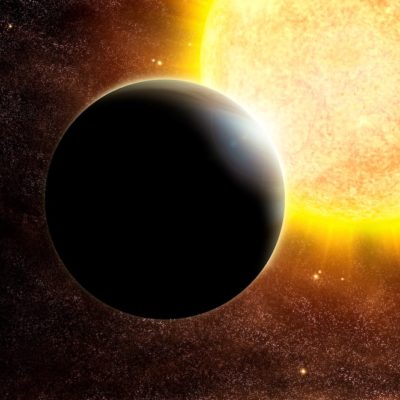
An earthlike home… far, far away
Exoplanets are seen as dark images occluding light from a star. (Image courtesy European Southern Observatory.)
Imagine a planet where the surface temperature is so hot that rocks melt into lava—or another where two suns dip below the horizon at dusk. Settings for a science fiction plot? Not to Massachusetts Institute of Technology astrophysicist and planetary scientist Sara Seager.
Seager studies just such exotic worlds. She is an explorer in search of habitable exoplanets: planets outside our solar system with conditions suitable for life and revolving around a star like our sun. On Oct. 12, she told an audience of science writers gathered at MIT for CASW’s annual New Horizons in Science briefings at ScienceWriters2015 how she and other scientists are now designing direct imaging missions that will zoom in on these faraway planets, bridging the gap between science fiction and fact.
Exoplanets cannot be found by gazing at the night sky; those twinkling stars you wish on are the suns of other solar systems in our own galaxy. And sending a probe to an exoplanet today is impossible. Even traveling at the speed of light (which still happens only in science fiction), a probe wouldn’t reach Seager’s favorite planet, HD 189733 b, for 63 years. Instead, NASA selected Seager and her team at MIT to develop ways to capture images of transiting planets – when they pass directly in front of their stars in orbit.
Capturing a planet in transit
An exoplanet directly in front of its star obscures some of the starlight. Scientists working on exoplanet identification use this to learn more about the planet. TESS (Transiting Exoplanet Survey Satellite) is a two-year MIT-led NASA imaging mission that will be launched in 2017. The project will survey the skies from both the northern and southern hemispheres, to observe exoplanets during transit and study each planet’s mass, size, density and orbit. In addition, telescopes studying the dimming of the starlight help determine the chemical composition of a planet’s atmosphere.
Exoplanets are incredibly diverse in mass, size, orbit, and atmospheric composition. “However, small planets are far more common than large planets throughout a planetary system,” Seager explained to the science writers.
Capturing planetary transits also involves a bit of serendipity. “Transits are limited to planetary systems with a fortuitous alignment,” Seager explained. The star, the planet, and the telescope must all align in a straight line. In the near future, Seager says, the transit boom is going to run out. The next technique will involve direct imaging.
Enter the starshade

Imaging a planet in transit is tricky. Seager attempts to describe it using a metaphor: Imagine taking a photograph of a lightning bug as it flies by a searchlight. Sounds difficult, isn’t it? Now try taking the same picture when the searchlight and the firefly are both thousands of miles away. While larger planets are easily captured because they obscure a greater amount of bright starlight, smaller planets in transit return overexposed images to the labs.
Developing this new phase of exploration requires Seager to get creative. To tackle the challenge, Seager has crafted a direct imaging device—the starshade—which can analyze all exoplanets.
Seager hopes the starshade will revolutionize the search for habitable exoplanets. This device looks like a shiny sunflower. Currently in the development phase, it is about the size of a large warehouse room. It utilizes the strength of telescopes and cameras, while providing the precision of direct imaging. When launched into space, the starshade will potentially be able to rendezvous with devices thousands of kilometers away, such as the James Webb Space Telescope, scheduled to launch in 2018.
After the shade aligns with a telescope, its petals will expand like a flower in bloom, and diffract the bright starlight away from the center of the shade. As a lonely exoplanet passes by, the telescope will capture only the light from the exoplanet and not the star. This image can help Seager and other scientists more accurately determine if the planet holds the potential for life.
Searching for a habitable planet
During the early days of the search for exoplanets, Seager and her colleagues believed that habitable exoplanets would fall in a “Goldilocks zone,” an area between the sun and outer system limits that is “not too hot” and “not too cold” for life to thrive. As of 2013, the criteria for “habitable” exoplanets have changed, where temperature range alone does not certify a planet as habitable. What is also necessary is identifying the chemical composition of a planet’s atmosphere.
Let us take the example of the one habitable planet we know—Earth. We have a surface temperature where water exists in a liquid form. However, the surface temperature of a planet is directly related to the greenhouse gases in the atmosphere. And greenhouse gas composition can vary depending on the planet’s size and distance away from the star. Earth and Venus have nearly the same size and mass, but while Earth flourishes with life, Venus is inhospitable. We also require a unique combination of chemicals to survive: water vapor, oxygen and carbon dioxide. And added to it are the chemicals exuded as life emerges. So all these factors put together are required to define a habitable planet.
Seager remains optimistically pragmatic. Whether habitable planets exist is no longer a question in her mind. The only question is when she will find them. She admits that a discovery of a true “Earth-twin” is years away, but the technology for finding another planet hospitable for life is nearly in place. The real challenge will be to confirm to the people of Earth that the stuff of their fantasies may be more than science fiction.